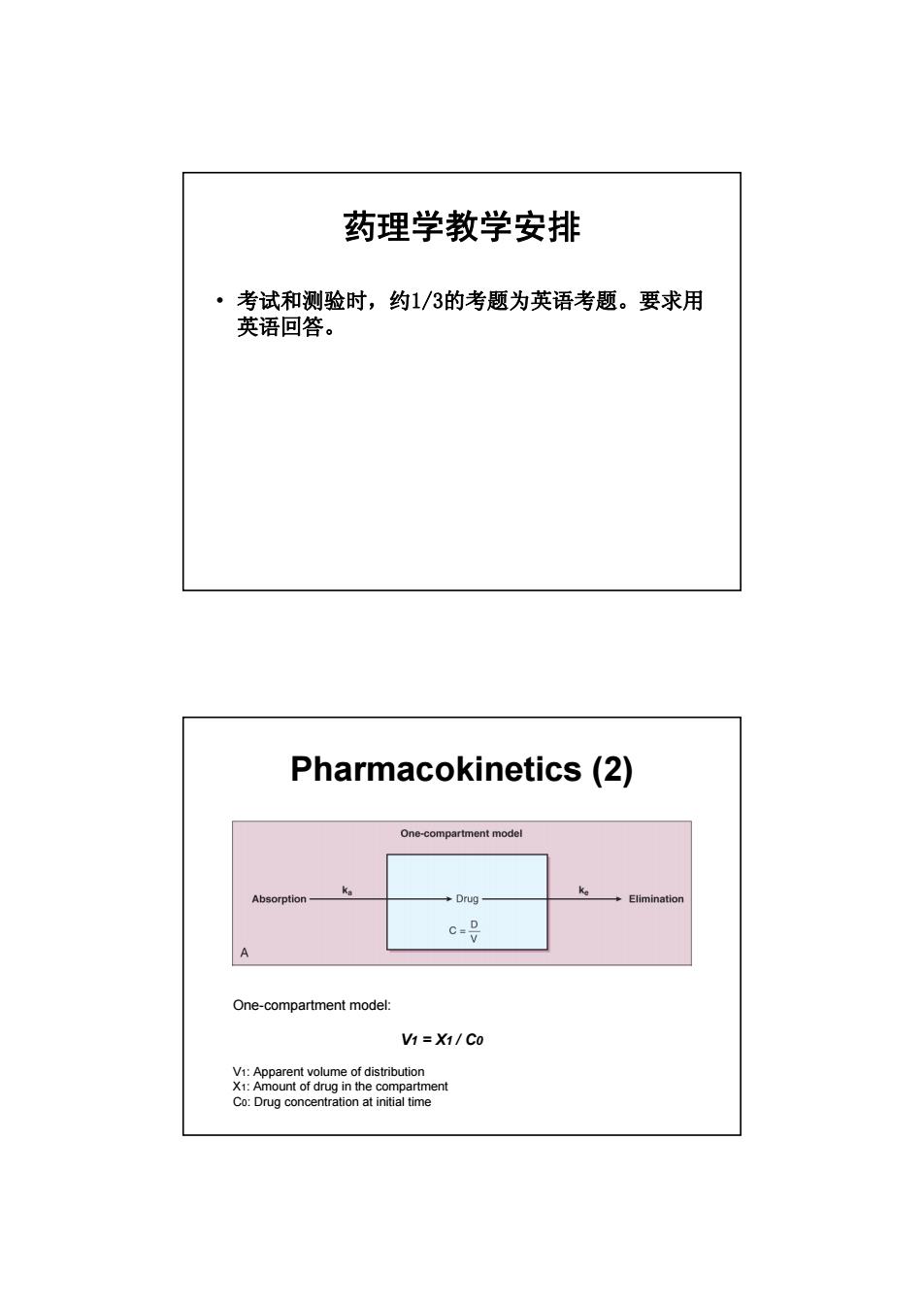
药理学教学安排 ·考试和测验时,约1/3的考题为英语考题。要求用 英语回答。 Pharmacokinetics(2) One-compartment model Absorption- Drug- Elimination c-v One-compartment model: V1=X1/Co V1:Apparent volume of distribution X1:Amount of drug in the compartment Co:Drug concentration at initial time
药理学教学安排 • 考试和测验时,约1/3的考题为英语考题。要求用 英语回答。 Pharmacokinetics (2) One-compartment model: V1 = X1 / C0 V1: Apparent volume of distribution X1: Amount of drug in the compartment C0: Drug concentration at initial time
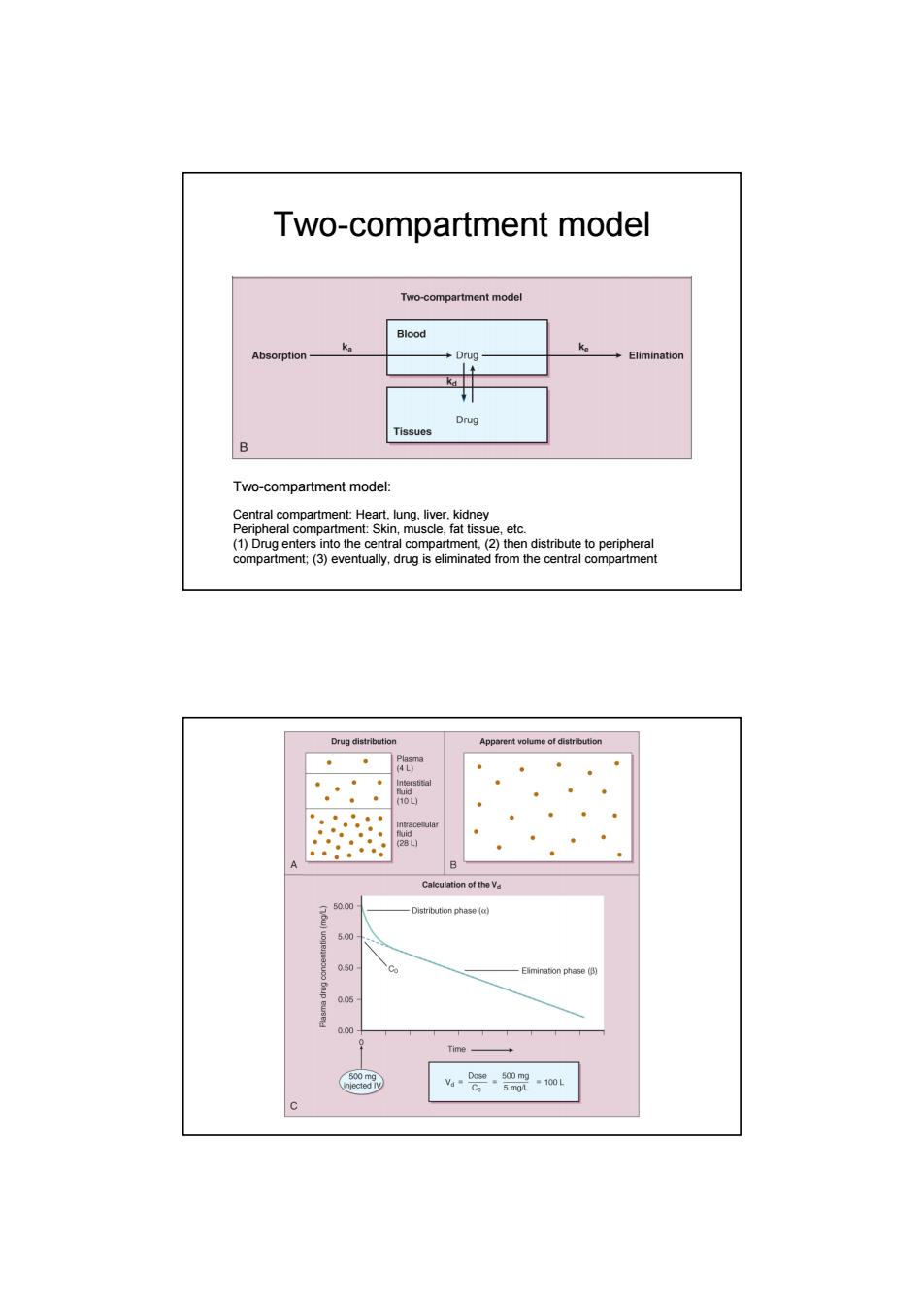
Two-compartment model Two-compartment model Blood Absorption- Drug Elimination Drug Tissues Two-compartment model: Central compartment:Heart,lung,liver,kidney Peripheral compartment:Skin,muscle,fat tissue,etc. (1)Drug enters into the central compartment,(2)then distribute to peripheral compartment;(3)eventually,drug is eliminated from the central compartment Drug distribution Apparent volume of distribution Plasma 4L) (10) A B Calculation of the Va (bw 50.00 Distribution phase(侧 5.00 -CP Elimination phase() 0.00 Time- =100
Two-compartment model Two-compartment model: Central compartment: Heart, lung, liver, kidney Peripheral compartment: Skin, muscle, fat tissue, etc. (1) Drug enters into the central compartment, (2) then distribute to peripheral compartment; (3) eventually, drug is eliminated from the central compartment
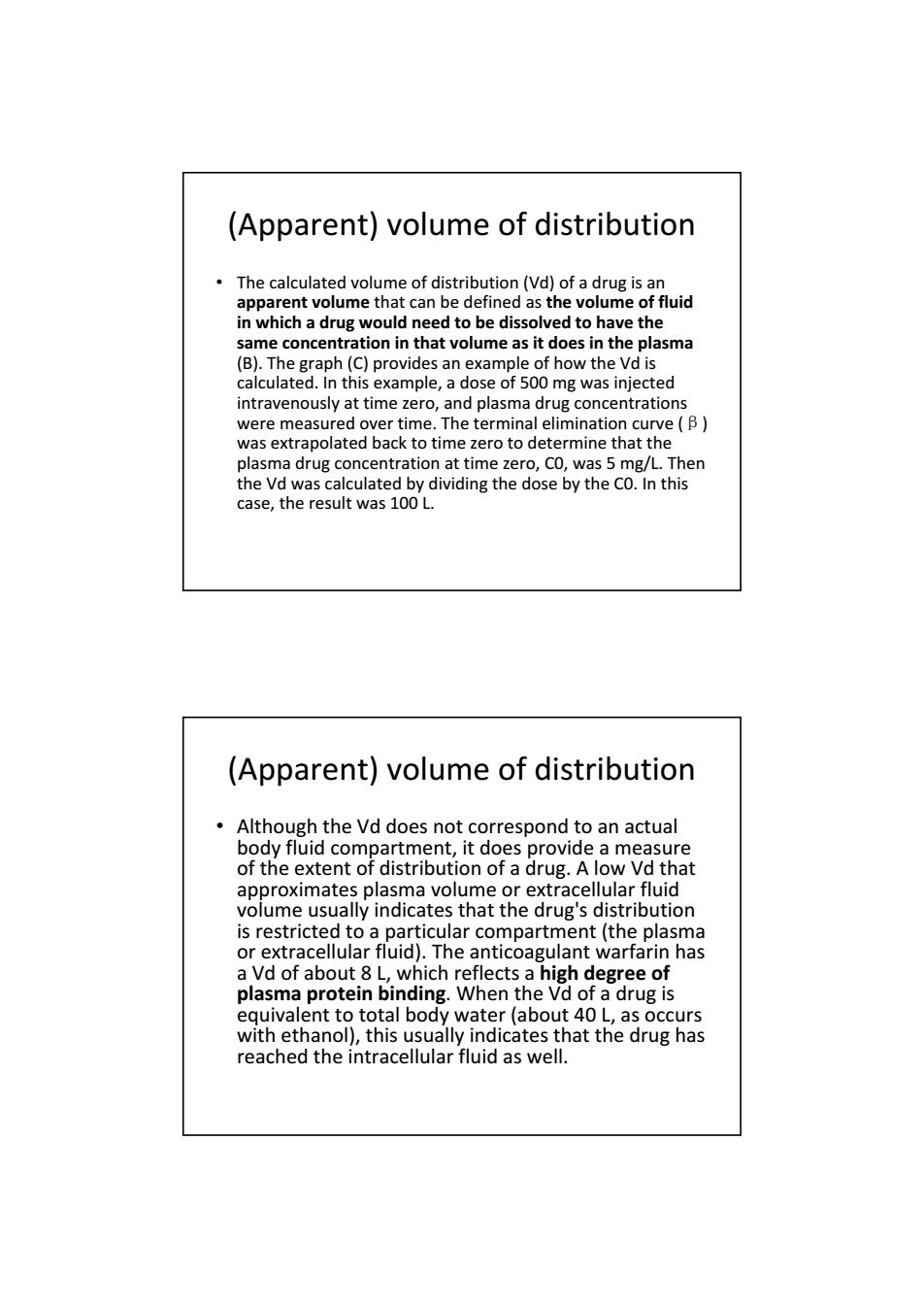
(Apparent)volume of distribution The calculated volume of distribution(Vd)of a drug is an apparent volume that can be defined as the volume of fluid in which a drug would need to be dissolved to have the same concentration in that volume as it does in the plasma (B).The graph(C)provides an example of how the Vd is calculated.In this example,a dose of 500 mg was injected intravenously at time zero,and plasma drug concentrations were measured over time.The terminal elimination curve(B) was extrapolated back to time zero to determine that the plasma drug concentration at time zero,Co,was 5 mg/L.Then the Vd was calculated by dividing the dose by the Co.In this case,the result was 100 L. (Apparent)volume of distribution Although the Vd does not correspond to an actual body fluid compartment,it does provide a measure of the extent of distribution of a drug.A low Vd that approximates plasma volume or extracellular fluid volume usually indicates that the drug's distribution is restricted to a particular compartment(the plasma or extracellular fluid).The anticoagulant warfarin has a Vd of about 8 L,which reflects a high degree of plasma protein binding.When the Vd of a drug is equivalent to total body water(about 40 L,as occurs with ethanol),this usually indicates that the drug has reached the intracellular fluid as well
• The calculated volume of distribution (Vd) of a drug is an apparent volume that can be defined as the volume of fluid in which a drug would need to be dissolved to have the same concentration in that volume as it does in the plasma (B). The graph (C) provides an example of how the Vd is calculated. In this example, a dose of 500 mg was injected intravenously at time zero, and plasma drug concentrations were measured over time. The terminal elimination curve (β) was extrapolated back to time zero to determine that the plasma drug concentration at time zero, C0, was 5 mg/L. Then the Vd was calculated by dividing the dose by the C0. In this case, the result was 100 L. (Apparent) volume of distribution • Although the Vd does not correspond to an actual body fluid compartment, it does provide a measure of the extent of distribution of a drug. A low Vd that approximates plasma volume or extracellular fluid volume usually indicates that the drug's distribution is restricted to a particular compartment (the plasma or extracellular fluid). The anticoagulant warfarin has a Vd of about 8 L, which reflects a high degree of plasma protein binding. When the Vd of a drug is equivalent to total body water (about 40 L, as occurs with ethanol), this usually indicates that the drug has reached the intracellular fluid as well. (Apparent) volume of distribution
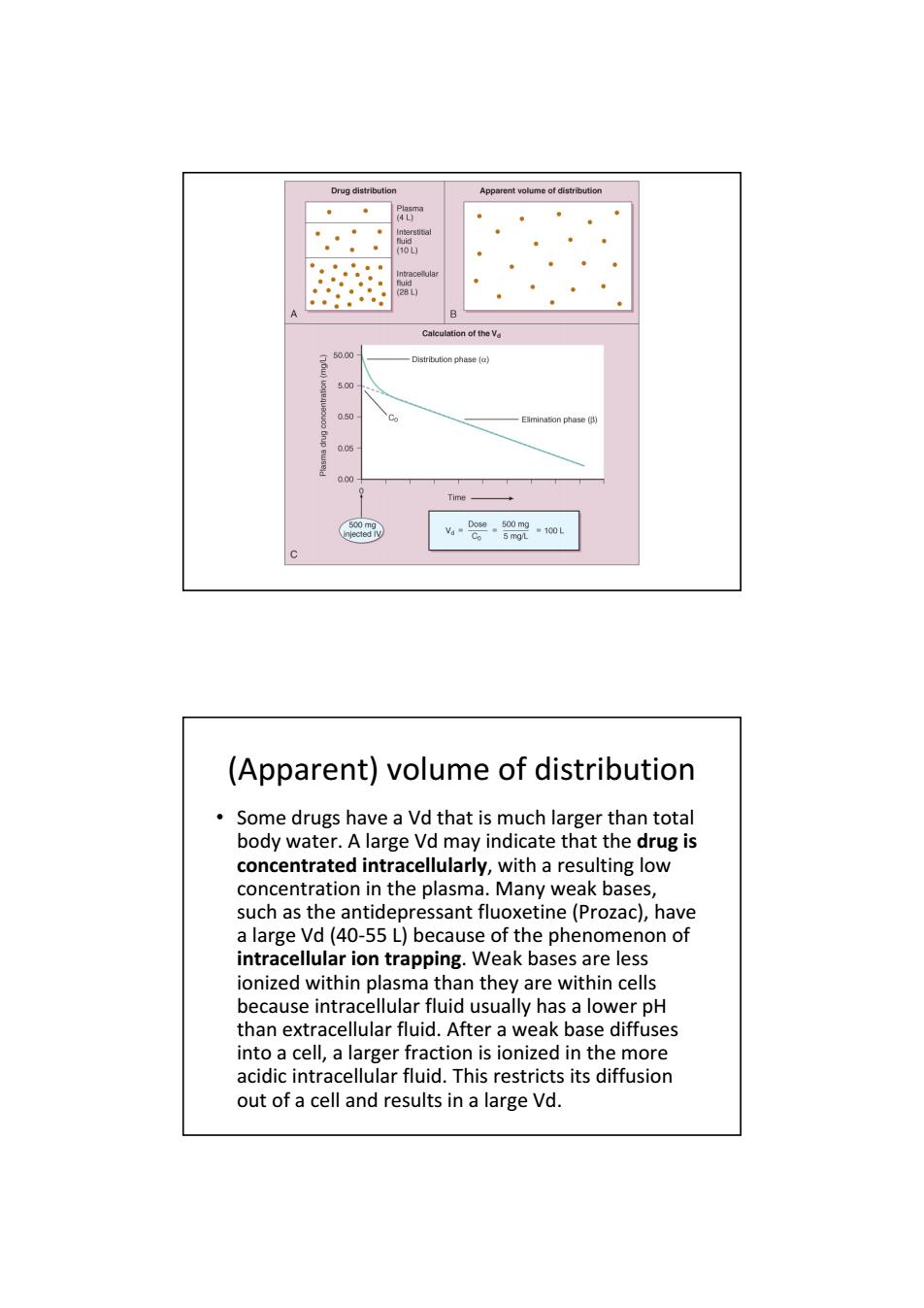
Drug distribution Apparent volume of distribution (10L) B Calculation of the Va 50.00 .6 Distribution phase(回) 5.00 0.50 -C Elimination phase() 0.05 0.00 Time- =100L (Apparent)volume of distribution Some drugs have a Vd that is much larger than total body water.A large Vd may indicate that the drug is concentrated intracellularly,with a resulting low concentration in the plasma.Many weak bases, such as the antidepressant fluoxetine (Prozac),have a large Vd(40-55 L)because of the phenomenon of intracellular ion trapping.Weak bases are less ionized within plasma than they are within cells because intracellular fluid usually has a lower pH than extracellular fluid.After a weak base diffuses into a cell,a larger fraction is ionized in the more acidic intracellular fluid.This restricts its diffusion out of a cell and results in a large Vd
• Some drugs have a Vd that is much larger than total body water. A large Vd may indicate that the drug is concentrated intracellularly, with a resulting low concentration in the plasma. Many weak bases, such as the antidepressant fluoxetine (Prozac), have a large Vd (40‐55 L) because of the phenomenon of intracellular ion trapping. Weak bases are less ionized within plasma than they are within cells because intracellular fluid usually has a lower pH than extracellular fluid. After a weak base diffuses into a cell, a larger fraction is ionized in the more acidic intracellular fluid. This restricts its diffusion out of a cell and results in a large Vd. (Apparent) volume of distribution
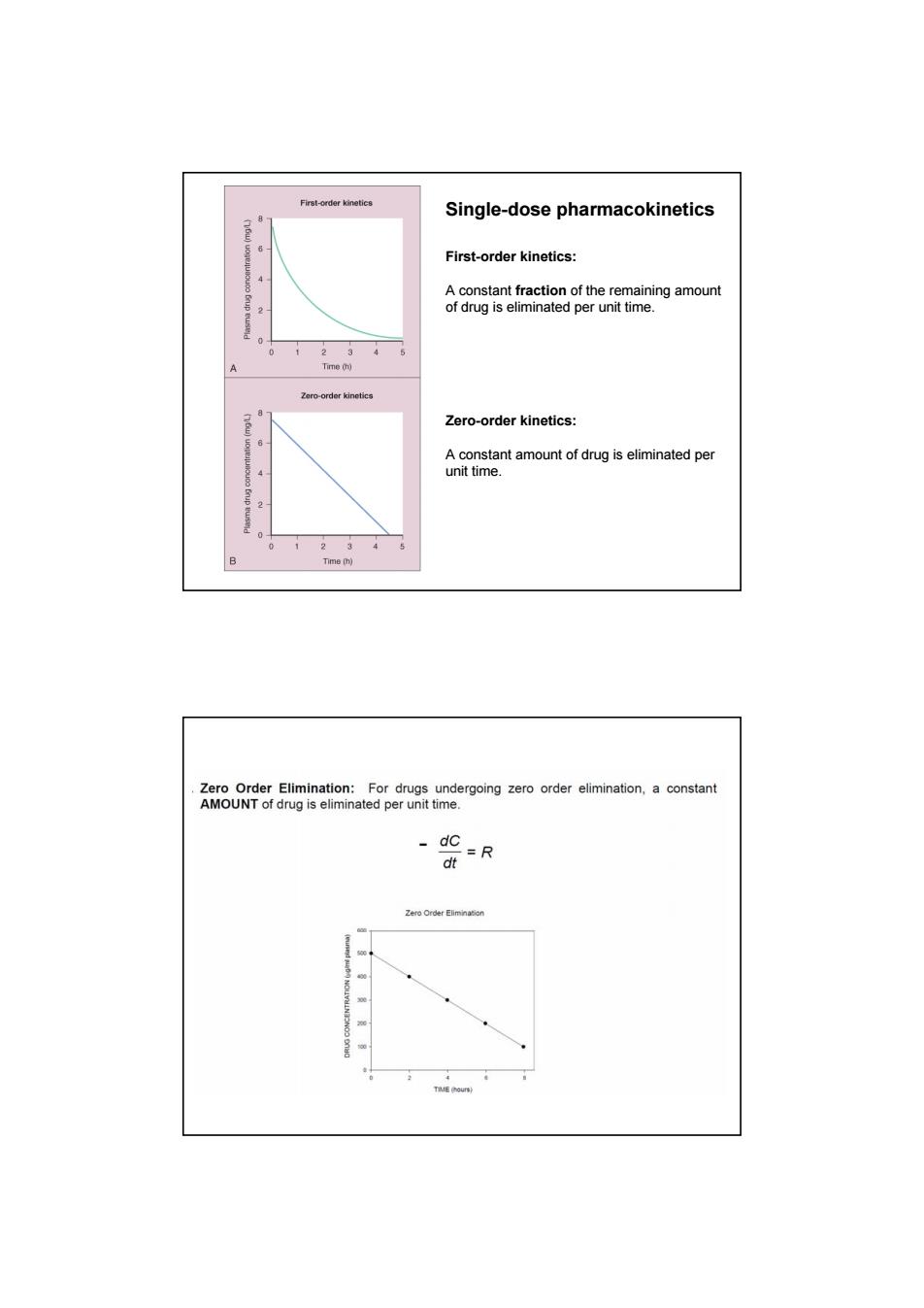
First-order kinetics Single-dose pharmacokinetics 8 8 First-order kinetics: 4 A constant fraction of the remaining amount 2 of drug is eliminated per unit time. 0 0 1 23 4 A Time (h) Zero-order kinetics Zero-order kinetics: A constant amount of drug is eliminated per 4 unit time. 2 0 0 1 2 4 Time (h) Zero Order Elimination:For drugs undergoing zero order elimination,a constant AMOUNT of drug is eliminated per unit time. dc =R dt Zero Order Elimination
First-order kinetics: A constant fraction of the remaining amount of drug is eliminated per unit time. Single-dose pharmacokinetics Zero-order kinetics: A constant amount of drug is eliminated per unit time